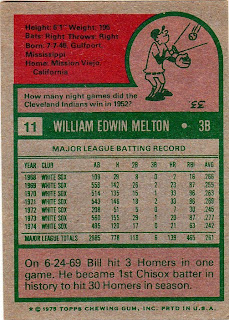 Card fact: This is Frank Tanana's first "solo card." In the 1974 set, he appears on a "Rookie Pitchers" card with three wannabes (Vic Albury, Ken Frailing and Kevin Kobel).
Card fact: This is Frank Tanana's first "solo card." In the 1974 set, he appears on a "Rookie Pitchers" card with three wannabes (Vic Albury, Ken Frailing and Kevin Kobel).What I thought about this card then: Never saw it. But I liked Tanana as a youngster. I always gravitated toward the second banana, if you want to call someone who could throw 100 mph second-best. But, hey, Nolan Ryan is Nolan Ryan.
What I think about this card now: The red-yellow color combo is among my favorites. And I continue to think Tanana is cool, even after the arm problems, and his complete overhaul into an offspeed specialist playing for the Red Sox, Rangers and Tigers. If only he could throw like he did in 1975 his entire career. We would be talking about a legend.
Other stuff: Tanana was responsible for the Red Sox trading Fred Lynn to the Angels. I can't remember what my brother thought of this trade, which is odd, because my brother is a Red Sox fan and Lynn was his favorite player. But I'm guessing it wasn't pleasant.
 Back facts: Tanana was a lefty. He was left-handed and could hit triple figures. THAT's why I liked him so much.
Back facts: Tanana was a lefty. He was left-handed and could hit triple figures. THAT's why I liked him so much.Other blog stuff: You didn't think I'd end the post without talking about the rookie cup did you? This is the first card with the rookie cup, and I will not run a 1975 Topps blog without seeing if Topps featured a full team of a Rookie Cuppers in its '75 set. So let the evaluating begin:
1B - ?
2B - ?
3B - ?
SS - ?
OF - ?
OF - ?
OF - ?
C - ?
P - Frank Tanana
We have our pitcher ...






































